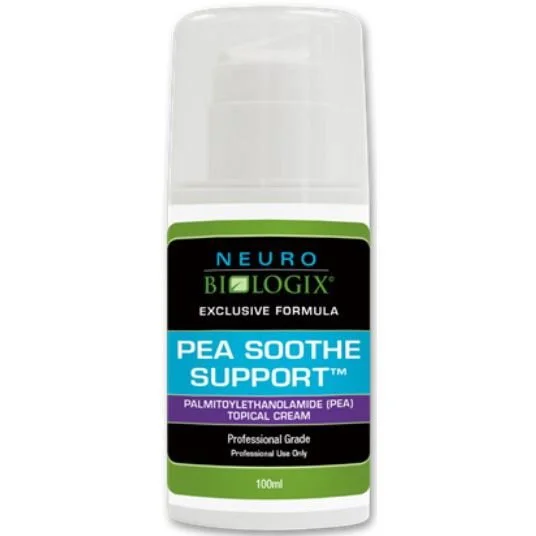PEA SOOTHE SUPPORT TOPICAL (100ML)
PEA SOOTHE SUPPORT TOPICAL (100ML)
PEA Topical Cream
Palmitoylethanolamid (PEA) is a bio-identical fatty acid amide that is normally synthesized by healthy tissue in the human body in response to inflammation. PEA is made by various plants and animals and is present throughout the animal kingdom. PEA can be found in many different tissues including glia, neurons, retina, white blood cells, mast cells and adipocytes.
Supplementing with time released PEA has been scientlfcally shown to naturally assist in the reduction of inflammation and to have neuro-protective and possibly pain control effects. This natural anti-inflammatory supports the nervous system and abnormal immune responses.*
Palmitoylethanolamide (PEA) – backed by more than 300+ medical studies, has been shown to be or assist with:
Natural pain reliever
Natural anti-inflammatory
Homeostasis regulator
Neuroprotective at the cellular level
Pain and nervous system issues
Muscle recovery and muscle pain
Immune system support*
What are Glial and Mast Cells?
Glial cells are various types of companion cells in the central and peripheral nervous system. Once thought to be nothing more than the glue that holds the brain together, these cells are now understood to have a much more complex role in the brain besides simply acting as a scaffold. Glial cells are responsible for nourishing neurons, facilitating nerve impulses, and exerting an inflammatory response on neurons. Dysregulation and over-activation of glial cells can have a detrimental effect on the nervous system[6,7,8].
Mast cells are a type of immune system cell that responds to chemical signals from tissue injury. When mast cells “degranulate,” they release a payload of inflammatory cytokines, NGF, histamines, and other molecules in the surrounding tissue. These chemicals attract white blood cells and activate their immune response against pathogens. Mast cells also activate nociceptors (pain receptors) with the chemicals they secrete. Overactive mast cell activation induces an increase in the density and sensitivity of pain receptors and can play a part in a variety of chronic pain issues.
How does it work?
It was discovered that mammals have a specific receptor cell known as the endocannabinoid system, which is closely interconnected with the nervous and immune system. CBD has been shown to boost every function of our cannabinoid receptors to help soothe and relax us. PEA has an affinity for the cannabinoid-like G-coupled receptors, although it has no affinity for the classical cannabinoid receptors CB1 and CB2. This is why it is sometimes referred to as a non-psychoactive “indirect endocannabinoid.”
It does not block pain signals the way opioids and other analgestics do. Instead it works upstream by supporting the healthy function of glial cells and mast cells.*
Please read our latest blog "PEA For Pain": http://neurobiologix.com/v/vspfiles/downloadables/PEAforPainBlog.pdf
Testimonials:
"I have had pain since my early 30's that pain medicine could never touch. I am talking about deep, throbbing nerve pain that was always a burden on my mind. I have been applying the PEA Soothe Topical cream to those areas and I am AMAZED! The pain is gone and I can't believe it! I am now 49 and thought I would have to live with the pain my entire life! Thank you for such a great product! - Sara F. (customer for life)
HELPFUL REFERENCE:
References:
New Targets in Pain, Non-Neuronal Cells, and the Role of Palmitoylethanolamide
Glial cell dysregulation: a new perspective on Alzheimer disease
Microglial cell dysregulation in brain aging and neurodegeneration
Disclaimer
*These statements have not been evaluated by the Food and Drug Administration. This product is not intended to diagnose, treat, cure, or prevent any disease. Not to be used by pregnant women.

